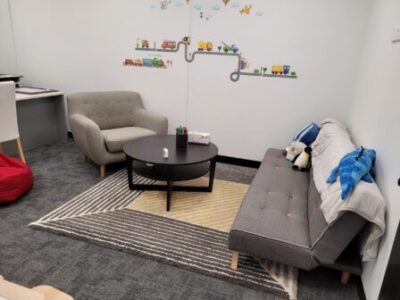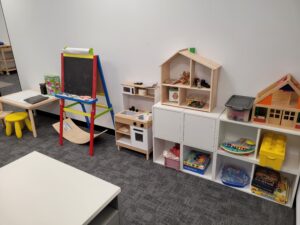What is Play Therapy? And how can it help your child?
laura on 30/01/2023

“Enter into children’s play and you will find the place where their minds, hearts, and souls meet.” -Virginia Axline
What is Play Therapy?
Play Therapy is an effective and appropriate way to help children aged 2-12 years work through emotional, psychosocial and behavioural difficulties. It can help address issues faced in the family, school, or interpersonal relationships. This technique works for children like counselling or psychotherapy does for adults.
Play Therapy is based upon the fact that play is the child’s natural medium of self-expression. In Play Therapy a child is given the opportunity to ‘play out’ feelings and problems just as an individual in adult therapy may ‘talk out’ their difficulties.
In Play Therapy, a relationship develops between the child and the therapist, where the therapist enters the child’s world, following the child’s lead, to develop a safe place and a relationship of trust, empathy and acceptance. Within this context, children are then free to express feelings, thoughts, experiences, and behaviours through play. Toys are used like words and become the child’s natural language. Children are encouraged to make choices, to explore possibilities and to develop resilience and self-actualisation, with a skillful therapist trained to respond therapeutically.
Who is Play Therapy for?
Play Therapy can assist children aged 2-12 years experiencing difficulties such as:
- Child abuse and neglect
- Developmental trauma
- Grief and loss
- Relationship and social issues
- Adjusting to family changes such as separation and divorce
- Social issues – difficulties with friendships, social skills
- Emotional regulation issues
- Anxiety
- Selective mutism
- Chronic illness or medical trauma
Benefits of Play Therapy:
Play Therapy provides a safe and therapeutic environment for children to explore and learn about themselves and their world, to build confidence and self-esteem, whilst working through the issues that may have hindered their development so far.
Play Therapy helps children to find healthier ways of communicating and to develop a greater sense of identity and self-esteem, while increasing their emotional intelligence and resilience.
Evidence based literature supports the effectiveness of play therapy, with research replicated with different cultural groups and demographics.
History and Adaptations of Play Therapy:
Virginia Axline originally developed Child-Centered Play Therapy as a methodology based on key principles of the person-centred approach, with primary focus on the relationship between child and therapist being based on genuineness, acceptance and trust. This created a safe and trusting environment for children to explore and examine all emotions and experiences at their own pace, and to integrate them. The therapist works with the child to provide empathy and unconditional acceptance, to help the child to feel understood, so they in turn can gain a sense of mastery and understanding of their own experiences.
In the 1960s, Bernard and Louise Guerney developed Filial Therapy, an adaptation of Play Therapy where parents were taught Child-Centered Play Therapy skills so that they could facilitate therapy sessions with their children. This model recognised the influential impact of parents in assisting their children’s healing and growth. Landreth refined this model into a 10-session structured program known as Child-Parent Relationship Therapy, an evidence-based model focused on strengthening the parent–child relationship and helping parents to better understand and respond to their children’s social, emotional, and behavioural needs.
Modern day Play Therapy incorporates many different methodologies adapted to the child’s age and stage of development, presenting issues, and stage of therapy. These can often incorporate structured or unstructured play, storytelling, art techniques, games and sand tray. The goal is still to provide an accepting and open environment for a child to feel safe to express their feelings, but techniques may utilise directive strategies as well.
If you would like to learn more about play therapy and how your child can benefit from this counselling approach, our team of clinicians can help.
References:
Axline, V. (1967; republished 1989). Play therapy: The inner dynamics of childhood. New York: Ballantine Books.
Bratton, S. C., Landreth, G. L., Kellam, T., & Blackard, S. R. (2006). Child parent relationship therapy (CPRT) treatment manual: A 10-session filial therapy model for training parents. Routledge/Taylor & Francis Group.
Cochran, N. H., Nordling, W. J. & Cochran, J. L. (2010). Child-centered play therapy: A practical guide to developing therapeutic relationships with children. New Jersey: John Wiley & Sons.
Landreth, G. L. (2012). Play therapy: The art of the relationship. New York: Routledge.
This blog was written by Shivonne Cammell – Senior Accredited Mental Health Social Worker at YMM.
Shivonne completed her undergraduate degree in psychology and neuroscience at Monash University, followed by a Master of Social Work at University of Melbourne.
Shivonne specialises in utilising play therapy to help children recover from trauma and grief, develop resilience, enhance family relationships, and adjust to new social circumstances in positive ways. She also has experience working with adolescents and adults to address issues including anxiety, low mood and depression, low self esteem and interpersonal difficulties.
Shivonne is a warm and approachable clinician, who works from a strength-based approach incorporating methodologies including cognitive behavioural therapy, acceptance and commitment therapy, interpersonal therapy, and relaxation and mindfulness strategies.
To learn more about Shivonne, check out the “Our Team” page on our website! https://yourmindmatters.net.au/our-team/
- Category: Child development and parenting, Child Therapy

